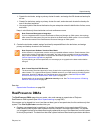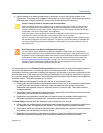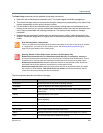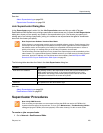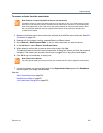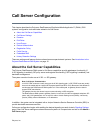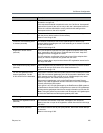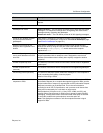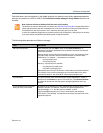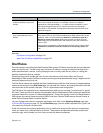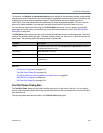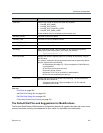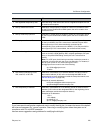
Call Server Configuration
Polycom, Inc. 235
Available bandwidth limit (percent) Sets the maximum percentage of the available bandwidth that can be
allocated to a single call.
If the requested bandwidth exceeds this value, the Call Server “downspeeds”
(reduces the bit rate of) the call, but only to the user’s downspeed minimum.
If there is insufficient bandwidth to comply with both this setting and the
downspeed minimum, the call is rejected.
Territory failover delay (seconds) The number of seconds a territory’s backup cluster waits after losing contact
with the primary before it takes over the territory.
Must be in the range 6-300.
Timeout for call forwarding when
no answer (seconds)
The number of seconds to wait for the called endpoint to answer (fully
connect) before forwarding the call, if call forwarding on no answer is enabled
for the called endpoint.
Must be in the range 5-32.
Registration refresh interval
(seconds)
For H.323 endpoints, specifies how often registered endpoints send “keep
alive” messages to the Call Server. Endpoints that fail to send “keep alive”
messages on time are flagged as inactive.
For SIP endpoints, specifies the refresh interval used if the endpoint didn’t
specify an interval or specified one greater than this value.
Must be greater than or equal to the minimum SIP registration interval and in
the range 150-9999.
Lync conference ID query timeout
(seconds)
When integrated with a Microsoft® Lync 2013 environment, limits the duration
of queries to the Lync 2013 server for a dialed conference ID.
Must be in the range 1-20.
For SIP calls gatewayed to an
external gatekeeper, use the
H.323 email ID as the destination
If this option is selected, when the system uses dial rules to attempt to resolve
a SIP call to an external gatekeeper, the Call Server sets the destination in the
LRQ message to the H.323 email ID (such as 1234@example.com) rather
than utilizing the E.164 number alone (such as 1234).
Some external gatekeepers, such as the RealPresence Access Director
system, may need the additional domain information in the LRQ message to
correctly resolve the LRQ request.
If this option is off, SIP calls gatewayed by the RealPresence DMA system to
a RealPresence Access Director configured as an external H.323 gatekeeper
fail because the gatekeeper doesn't have enough information to route the call.
Note: This option affects communications with all external H.323 gatekeepers
to which the RealPresence DMA system gateways SIP calls.
SIP Settings
Minimum SIP registration interval
(seconds)
The minimum time between “keep alive” messages to SIP endpoints.
Must be less than or equal to the registration refresh interval and in the range
150-3600.
SIP peer timeout (seconds) The timeout value for calls to peer proxy servers, after which the dial attempt
is canceled.
Must be in the range 3-300.
Field Description



